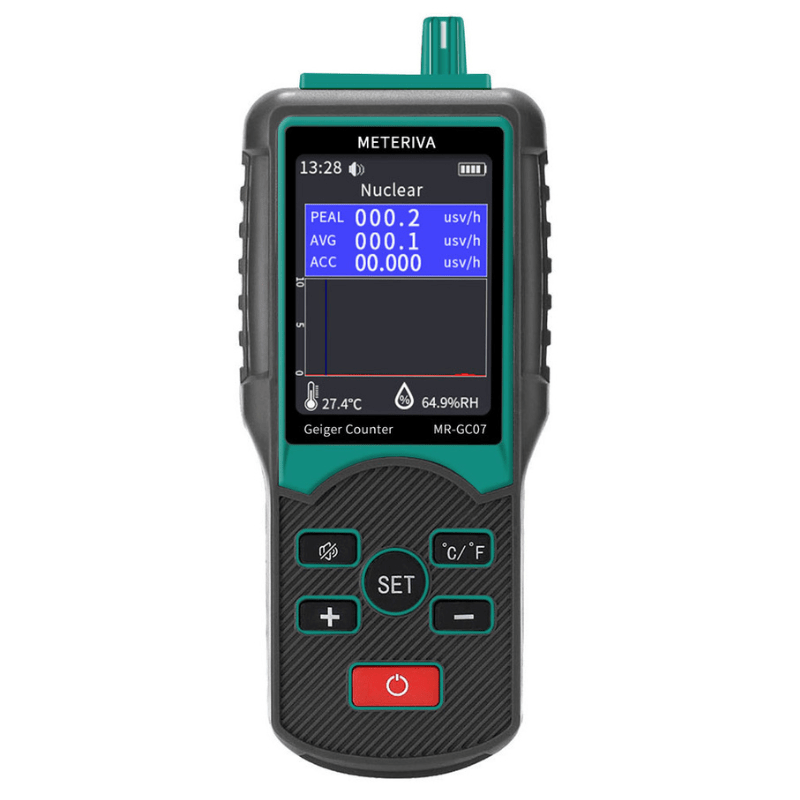Geiger Counter
METERIVA Geiger Counter / Radiation Survey Meter
A Geiger Counter is a kind of nuclear detector which is capable of detecting different kinds of nuclear radiation like alpha particle, beta particle, and gamma rays. The Geiger Counter sometimes also referred to as GM Counter, Radiation Detector, Geiger-Muller Counter, and Radiation Survey Meter. The construction GM counter mainly consists of the geiger-müller tube which is nothing but a hollow cylinder. It contains some kind of a gaseous medium and the gaseous medium is usually consisting of some kind of a noble gas like argon and a mixture of other alcohol compounds. This acts as a cathode. And through the center of the cylinder, a metallic electrode is made out of tungsten. This is connected to a load resistance, and which is again connected to the positive terminal of the same power supply.
Across the load resistance, you have some kind of an electronic setup. Which is basically capable of determining any kind of a potential drop that happens across load resistance, and also measuring the amount of current pulse associated with that. This is also associated with some kind of counter that can count that kind of event over a while.
Geiger Counter In Use
The working mechanism of Geiger Counter.
The working mechanism of the Geiger Counter setup is very simple. When some kind of an external particle, like an alpha particle or a beta particle or a gamma radiation, it enters in the medium. Then it leads to ionization.
What is ionization?
When some external nuclear particle, like an alpha particle, comes into a material medium, it collides with the molecules of the material medium and transfers energy to the molecules of the material medium. Now the electrons in the outermost shells of these molecules and atoms, absorb some of that energy. If the energy is sufficient enough, these electrons become free, leading to the creation of a positive ion and a free electron.
So the effect of an external nuclear particle is basically in the ionizing the gas, which is inside this kind of a detector. So it basically end up getting a positive ion and a negative electron due to the ionization caused by some kind of a external nuclear particle. Now, this positive ion and the negative electron when they are created by some external nuclear particle, they are subjected to an external electric field. So the central electrode is connected to the positive terminal of the battery, and the metallic surface is connected to the negative terminal of the battery.
So the central electrode is acting as an anode and a metallic surface is acting as a cathode. And there is going to be an electric field which is directed in this particular direction. So when the positive ion and electron is created, they will be subjected to an extremely high electric field. Now GM counters are distinct from other nuclear detectors like proportional counters or ionization chambers, in the sense that the battery is capable of inducing an extremely high amount of potential difference. Here we have a battery which is capable of creating a potential difference of around 1000 to 3000 volt, so this is a huge amount of potential difference. Under this potential difference, the electron will experience acceleration in this particular direction, and the positive ion will experience acceleration in this particular direction.
How can now radioactive radiation be measured?
Let us assume that beta radiation, that is, an electron, flies through the very thin window into the cylinder. This then hits a noble gas atom and knocks an electron of this atom out of the atomic shell. Both electrons are strongly attracted to the positively charged wire. After the collision. On the way to the wire, the electrons collide with other electrons from other noble gas atoms. These are also knocked out of the atomic shells of the atoms.
This leads to what is known as an electron avalanche so that many electrons reach the wire. The now positively charged noble gas atoms are attracted to the negatively charged cylinder wall, where they recombine with electrons so that they are neutrally charged again. The electrons in the wire now flow to the positive pole of the connected power supply unit. You can get to the positive pole in two possible ways. Once through the very large resistor R and once through the counter. Since the resistance is very high, most of the electrons flow through the counter. The counter registers the current pulse and now shows the value one.
The value increases by one for each current pulse. For example, a Geiger-müller counter can be used to measure the number of radioactive particles that fly into the cylinder.

